Renault Clio
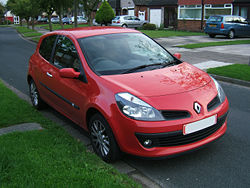 |
|
| Manufacturer | Renault |
|---|---|
| Also called | Renault Lutecia |
| Production | 1990–present |
| Predecessor | Renault 5 |
| Class | Supermini |
| Layout | FF layout |
The Renault Clio is a supermini car produced by the French automobile manufacturer Renault. Originally launched in 1990, it is currently in its third generation. The Clio has seen substantial critical and commercial success, being consistently one of Europe's top-selling cars since its launch, and it is largely credited with restoring Renault's reputation and stature after a difficult second half of the 1980s.
The Clio has been sold as the Renault Lutecia in Japan, as Honda owns the right to the name Clio in Japan (being one of Honda's sales networks in Japan). A four-door saloon was developed for certain markets where sedans are traditionally preferred over hatchbacks and is sold under names Renault Clio Classic, Renault Clio Symbol, Renault Clio Sedan, Renault Clio Tricorps, and Renault Thalia. It is also sold under the Nissan nameplate in some Latin American markets as the Nissan Platina with slight changes in the front of the car to make it resemble the Nissan Altima. Both the Renault Clio (5 door hatchback) and the Nissan Platina (4 door sedan) are marketed in Mexico, each by their respective manufacturer.
Contents |
Clio I (1990-1998)
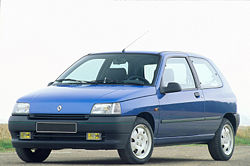 |
|
| Manufacturer | Renault |
|---|---|
| Production | 1990–1998 |
| Assembly | Delhi,India Strasbourg,France Beijing,China Bursa,Turkey |
| Body style(s) | 3-door hatchback 5-door hatchback |
| Engine(s) | 1.2 L C-Type I4 1.2 L D-Type I4 1.2 L E-Type I4 1.4 L E-Type I4 1.7 L F-Type I4 1.8 L I4 1.9 L F-Type diesel I4 2.0 L I4 |
The Clio was introduced at the Paris Motor Show in June 1990 and sales in France and the rest of the continent began then, although sales in Britain did not begin until March 1991. The Clio largely replaced the Renault 5 (which continued to be built in lower volumes until 1996 in Slovenia as a budget alternative). The engine range available at launch included 1.2 L and 1.4 L E-type "Energy" petrol I4 engines (first seen in the R19) and 1.7 L and a 1.9 L diesel (both based on the F-type unit) engines. The petrol engines all received an electronic fuel injection system in place of carburettors in 1992, in order to conform to new pollutant emission regulations.
A minor trim facelift occurred after only a year of being on sale. A new "smooth" version of the Renault diamond badge (the previous "ribbed" badge was being phased out at the time) and a new front seat design were the only changes. The altered design did not constitute a new "phase". In March 1994, the Phase 2 model was launched, with small updates to the exterior and interior of the Clio. Most noticeable was the change in the front grille from two metal ribs to a single colour-coded slat grille. The bump strips were made slightly larger and rounder, and the car's trim level badge was incorporated into the bump strips. The badges on the tailgate strip were moved up onto the tailgate itself and the tailgate strip was given a carbon fibre look. The rear light clusters were given a slightly more rounded bubble shape to them, giving the Clio a more modern look. The clusters, however, are physically interchangeable with Phase 1 clusters.
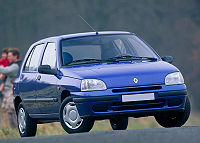
In 1996, with the arrival of the Phase 3 facelifted Clio, the 1.2 L Energy engine was replaced by the 1149 cc D7F MPi (Multi Point Injection) DiET engine, first used in the Renault Twingo; for some time also, versions were available with the older 1239 cc "Cléon" unit from the original Twingo. The cylinder head design on the 1.4 L E-Type was also slightly altered for the Phase 3 models in a bid for better fuel economy. This resulted in the engines producing slightly less power than their earlier versions.
The Phase 3 Clios had a slightly more noticeable update than the Phase 2's. The Phase 3 has different, more rounded headlights, incorporating the turn signal in the unit with the headlight. The bonnet curved more around the edges of the lights. The tailgate incorporated a third brake light and a new script "Clio" name badge, following the same typeface as contemporary Renaults. Some mechanical improvements were also made.
During 1991, a 1.8 L 16-valve engine producing 137 PS (101 kW) (also first seen in the R19) capable of propelling the car to 208 km/h (129 mph) was introduced to the Clio engine range, known simply as the Clio 16S in France (S for "soupappe", the French word for valve), and Clio 16V in export markets. As well as having higher top speed than a regular Clio, the 16S sported wider plastic front bumpers, an offset bonnet vent, wider rear bumpers and uprated suspension and brakes, and colour-coded front mirrors and bumpers.
Renault also released a warm hatch version of the Clio. It was aesthetically very similar to the Clio RT & 16S, but with the addition of a 110 PS (81 kW) 1.8 L 8-valve engine, side skirts and disc brakes on all wheels. This was badged as the RSi. As with the Volkswagen Golf MK2's 8- and 16-valve GTI variants, the 8-valve model had more torque at lower engine revs and was more of a "drivers car" on winding roads.
The Clio was voted European Car of the Year for 1991, and soon became one of Europe's best-selling cars, as well as the first Renault to be consistently among the top-10 best sellers in the United Kingdom. UK sales were helped by a famous television advertising campaign by Publicis shot in France, featuring the two main characters of Nicole (played by Estelle Skornik, who was not French nor did she have a driving licence at the time) and Papa.
From 1991 to 1994, trim levels were identical in every European country. Starting in 1994, each country of sale had individual trim levels designations.
Sales across Europe were strong throughout its production life, and a decade after its demise it is still a common sight on Europe's roads.
Clio Williams
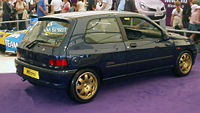
In 1993, Renault launched the Clio Williams with a limited run of 400, for racing homologation purposes. The car was named after the then Renault-powered Formula One team WilliamsF1 but Williams had nothing to do with the design or engineering of this Clio; the modifications to the Clio 16S on which it was based were the work of Renault Sport, Renault's motorsport division.
The a 2.0 L 16-valve straight-4 engine rated at 150 PS (110 kW) and a top speed of 215 km/h (134 mph), with performance-tuned ride and handling. Renault later released the Williams 2 and Williams 3 special editions, much to the chagrin of those owners who had been assured of the exclusivity of the "original" Williams. The differences between the three versions of the Williams were largely a reflection of phase changes across the Clio range e.g. the gradual addition of enhanced safety features and cosmetic variations. Other than this, the Williams 1 and 2 had no sunroof and were painted in 449 Sports Blue. The final Williams 3 was painted in a slightly brighter shade of blue (432 Monaco Blue) and finally gained a sunroof which had long been standard on virtually all previous Clios. The original Williams was the lightest of the three, lacking the electrics necessary for the sunroof or the mirrors but was the only one to sport a metal plaque stating the build number.
Respected motoring journalists consistently rate the Williams as one of the very best hot hatches ever made, regardless of era. One common mistake people can make is thinking that the 2.0 16V (F7R) used in the Williams is simply a bored out 1.8 16V (F7P), whereas, in reality the large engine had different size valves, cams and crank. Other differences between the Williams and the Clio 16S it is based on include a wider front track with some parts borrowed from the Renault 19. wider speedline alloys, uprated (JC5) gearbox, bespoke four-to-one manifold, firmer suspension and some cosmetic differences on the exterior and interior.
Clio II (1998–2005)
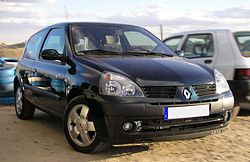 |
|
| Manufacturer | Renault |
|---|---|
| Also called | Nissan Platina Renault Clio Classic Renault Clio Campus Renault Thalia Renault Clio Storia Renault Lutecia (Asia) |
| Production | 1998–present (under the names of Clio Campus, Clio Classic and Clio Storia) |
| Assembly | Strasbourg,France Buenos Aires,Argentina Bursa,Turkey Novo Mesto,Slovenia (Renault Clio Storia) |
| Body style(s) | 3-door hatchback 4-door sedan 5-door hatchback |
| Engine(s) | 1.2 L I4 1.4 L I4 1.5 L diesel I4 1.6 L I4 1.9 diesel I4 2.0 L I4 |
| Wheelbase | 0 mm (0 in) |
| Length | 3,811 mm (150 in) |
| Width | 1,639 mm (65 in) |
| Height | 1,417 mm (56 in) |
| Curb weight | 990 kg (2,183 lb) |
The all-new second generation of the Clio was launched in the spring of 1998, with considerably more rounded and bulbous styling than its predecessor. Part of the radical concept of the new Clio were many components made of unusual materials to save in weight and repair costs. For instance, the front wings were made of plastic (Following on from criticisms of corrosion in this part of the previous model and based on technology developed for the Renault Espace) and the material of the bonnet was aluminium in some versions. Originally the engine lineup was similar to before, with 1.2 L, 1.4 L and 1.6 L petrol engines and a 1.9 L diesel. In early 1999, a sportive 16V version equipped with a new 1.6 L 16-valve engine was introduced, and eventually, all the older petrol engines were upgraded to more powerful and more economical 16-valve versions.
In 1999, Renault launched the 169 PS (124 kW) Clio Renault Sport (also known as Clio RS for short, named Clio Renault Sport 172 in the UK - 172 coming from the DIN method horsepower measurement), with a 2.0 L 16-valve engine and a top speed of 220 km/h (140 mph). But in this form, the car is capable of surprisingly good handling and performance. The top-of-the-range Clio, however was the mid-engined, rear-wheel drive Clio V6 Renault Sport, originally engineered by Tom Walkinshaw Racing for a one-make racing series, which placed a 230 PS (170 kW) 3.0 L V6 engine, sourced from the Renault Laguna behind the front seats, with a top speed of 235 km/h (146 mph).
A facelift occurred in the spring of 2001 which saw the exterior restyled (most visibly the headlights were made more angular), the interior quality improved and a 1.5 L direct injection Diesel engine added. In 2006 the Phase 2 model was facelifted with a restyled front and rear. The number plate moves from boot to bumper and a better specification on all Campus models introduced. The Clio Renault Sport's power was improved to 179 PS (132 kW) (in the UK, the designation RS 182 was adopted, once more using in reflection of DIN-measured horsepower).
After the introduction of the Clio III in 2005, Renault continues to market the Mk 2 as the Renault Clio Storia or Renault Clio Campus, depending on the market, with a reduced engine and model range. In the UK, the model continues to sell alongside the newly introduced Renault Twingo, which shares it floorpan and retails at the same price level.
Clio Symbol/Clio Sedan/Symbol/Thalia (2001-present)
In 2001 Renault launched the saloon version of the Clio II, named Clio Symbol (Turkey, Romania and Bulgaria), Thalia (the rest of Eastern Europe), Symbol (Colombia) or Clio Sedan (the rest of South America). Originally, the car was intended for sale in developing countries, but due to demand, it was later made available in countries where saloons were traditionally preferred over hatchbacks, most notably in Eastern Europe, where the Thalia is cheaper than the Clio, but is still about 30% more expensive than the Dacia Logan, which is also sold by Renault in that market but is a low cost model. In some markets, the sedan is offered as the Nissan Platina (manufactured in Aguascalientes, Mexico).
Beginning in 2007, an improvised third-generation Clio Symbol has been offered in Turkey and Bulgaria as Renault Symbol. This model features the interior of the facelifted Clio II with very minor parts commonality with Megane II, as well as new standard and optional equipment, such as automatic air conditioning and a CD player. The model earned moderate reception in the domestic market. Nonetheless, it is expected to remain in production until late 2008, when a sedan version of Clio III is expected.
Clio III (2005-present)
 |
|
| Manufacturer | Renault |
|---|---|
| Also called | Renault Euro Clio (Mexico) |
| Production | 2005–present |
| Assembly | Strasbourg,France Delhi,India Bursa,Turkey |
| Body style(s) | 3-door hatchback 5-door hatchback 5-door estate |
| Wheelbase | 2,451 mm (96 in) |
| Length | 3,986 mm (157 in) |
| Width | 1,707 mm (67 in) |
| Height | 1,497 mm (59 in) |
| Curb weight | 1,150 kg (2,535 lb) |
| Related | Nissan Micra Renault Modus |
An all-new third generation Clio was unveiled in 2005. It uses a platform co-developed with Nissan (which Renault has a share in) that is shared with the Renault Modus, the current Nissan Micra and the Nissan Note. It is considerably larger and 130 kg (287 lb) heavier as well as more expensive than the Clio II, and at nearly 4000 mm in length has almost outgrown the supermini class. This was the result of a decision to move the Clio upmarket. It also brings the trademark "Renault Card" keyless immobiliser to the Clio for the first time. The new Clio achieved a 5-star EuroNCAP safety rating, joining the rest of Renault's family at the maximum safety rating (with the exception of Kangoo and Twingo). Sales began throughout Europe in October 2005. It was voted European Car of the Year 2006, and was considered by the judges to be the car which will set the benchmark for quality, safety and style for a car in this class.
In June 2006 the sales of the third generation Clio Renault Sport started in France for the price of €23000. The Clio Renault Sport is equipped with a new naturally aspirated 16-valve 2.0 L engine based on the earlier version used in the second generation Clio Renaultsport and a 6-speed gearbox. The engine develops 197 PS (145 kW) at 7250 rpm. The top speed is 215 km/h (134 mph) and 0-100 km/h takes 6.9 seconds.
Renault exhibited a Hi-Flex Clio Mk II with a 1.6 L 16-valve engine at the 2006 Paris International Agricultural Show. This vehicle, which addresses the Brazilian market (where this engine is available in the Clio II, the third generation not being sold there), features Renault-developed flex-fuel technology, with a highly versatile engine that can run on fuel containing a blend of gasoline and ethanol in any proportion (0% to 100% of either).
An estate version, the Sport Tourer, was unveiled in March 2007. At the same time, Renault replaced the 1.4 L atmospheric engine with a new turbocharged 1.2 TCE version, with 101 PS (74 kW) and 145 N·m (107 ft·lbf) of maximum torque.
According to Auto Express magazine in the UK, a restyled Clio III will go on sale in early 2009. It will be a fully face-lifted version of the current model, with better quality materials used in the interior and will be better equipped than the current model.[1]
Engines
| Engine | Type | Power | Top speed | 0-100 km/h | Availability |
|---|---|---|---|---|---|
| 1.0 L (999 cc) | 8-valve I4 | 58 PS (57 hp/43 kW) | 144 km/h (89 mph) | 18.2 s | Brazil, 2002-2007 |
| 1.0 L (999 cc) (gas/ethanol) | 16-valve I4 (D4D) | 77 PS (76 hp/57 kW) | 165 km/h (103 mph) | 14.1 s | Brazil, 2003-present |
| 1.2 L (1149 cc) | 8-valve I4 | 58 PS (57 hp/43 kW) | 160 km/h (99 mph) | 13.5 s | 1996-1998-Present, Clio Campus/Storia GPL |
| 1.2 L (1149 cc) | 16-valve I4 (D4F) | 76 PS (75 hp/56 kW) | 170 km/h (106 mph) | 13.0 s | 2001-present |
| 1.2 L (1171 cc) | 8-valve I4 | 60 PS (59 hp/44 kW) | 155 km/h (96 mph) | 15.2 s | 1990-1995 |
| 1.2 L (1239 cc) | 8-valve I4 | 54 PS (53 hp/40 kW) | 150 km/h (93 mph) | 14.5 s | 1995-1996 |
| 1.4 L (1390 cc) | 8-valve I4 | 80 PS (79 hp/59 kW) | 175 km/h (109 mph) | 11.2 s | 1997 |
| 1.4 L (1390 cc) | 8-valve I4 | 75 PS (74 hp/55 kW) | 170 km/h (106 mph) | 12.0 s | 1998-2001 |
| 1.4 L (1390 cc) | 16-valve I4 | 98 PS (97 hp/72 kW) | 185 km/h (115 mph) | 11.2 s | 1998-present |
| 1.5 L (1461 cc) | 8-valve dCi I4 | 65 PS (64 hp/48 kW) | 162 km/h (101 mph) | 15.0 s | 2001-2005 |
| 1.5 L (1461 cc) | 8-valve dCi I4 | 68 PS (67 hp/50 kW) | 162 km/h (101 mph) | 15.2 s | 2005-present |
| 1.5 L (1461 cc) | 8-valve dCi I4 | 86 PS (85 hp/63 kW) | 174 km/h (108 mph) | 12.7 s | 2001-present |
| 1.5 L (1461 cc) | 8-valve dCi I4 | 101 PS (100 hp/74 kW) | 185 km/h (115 mph) | 10.6 s | 2001-2005 |
| 1.5 L (1461 cc) | 8-valve dCi I4 | 106 PS (105 hp/78 kW) | 190 km/h (118 mph) | 11.1 s | 2005-present |
| 1.6 L (1598 cc) | 8-valve I4 | 88 PS (87 hp/65 kW) | 177 km/h (110 mph) | 11.9 s | 1998-1999 |
| 1.6 L (1598 cc) | 16-valve I4 | 110 PS (108 hp/81 kW) | 194 km/h (121 mph) | 9.6 s | 1998-2005(1999-2001 16v-sport version) |
| 1.6 L (1598 cc) | 16-valve I4 | 112 PS (110 hp/82 kW) | 190 km/h (118 mph) | 10.2 s | 2005-present |
| 1.7 L (1698 cc) or(1721 cc) | 16-valve | 90 PS (89 hp/66 kW) | 205 km/h (127 mph) | 9.2 s | 1990-1991 |
| 1.8 L (1794 cc) | 8-valve I4 | 95 PS (94 hp/70 kW) | 185 km/h (115 mph) | 9.9 s | 1990-1998 |
| 1.8 L (1794 cc) | 8-valve I4 | 110 PS (108 hp/81 kW) | 195 km/h (121 mph) | 8.6 s | RSi |
| 1.8 L (1764 cc) | 16-valve I4 | 137 PS (135 hp/101 kW) | 209 km/h (130 mph) | 7.7 s | 16S/16valver |
| 1.9 L (1870 cc) | 8-valve D I4 | 64 PS (63 hp/47 kW) | 161 km/h (100 mph) | 14.8 s | Clio I, Clio II |
| 1.9 L (1870 cc) | 8-valve dTi I4 | 80 PS (79 hp/59 kW) | 175 km/h (109 mph) | 13.0 s | Clio II |
| 2.0 L (1997 cc) | 16-valve I4 | 138 PS (136 hp/101 kW) | 205 km/h (127 mph) | 8.5 s | |
| 2.0 L (1998 cc) | 16-valve I4 | 150 PS (148 hp/110 kW) | 215 km/h (134 mph) | 7.8 s | 16S Williams |
| 2.0 L (1998 cc) | 16-valve I4 | 169 PS (167 hp/124 kW) | 220 km/h (137 mph) | 7.2 s | 2000-2004, RS |
| 2.0 L (1998 cc) | 16-valve I4 | 179 PS (177 hp/132 kW) | 222 km/h (138 mph) | 7.1 s | 2004-2006, RS |
| 2.0 L (1998 cc) | 16-valve I4 | 197 PS (194 hp/145 kW) | 215 km/h (134 mph) | 6.9 s | 2006-present, RS |
| 3.0 L (2946 cc) | 24-valve V6 | 230 PS (227 hp/169 kW) | 235 km/h (146 mph) | 6.4 s | |
| 3.0 L (2946 cc) | 24-valve V6 | 255 PS (252 hp/188 kW) | 245 km/h (152 mph) | 5.8 s | 2000-2004, RS |
Consumer safety issues (Watchdog)
In April 2006, UK consumer affairs TV programme Watchdog aired details of incidents involving a number of Clio IIs in which the bonnet flew open without warning whilst being driven - The problem was traced to a faulty safety catch.
The problem was originally brought to the attention of Watchdog by a member of an independent Renault community (RenaultForums) whose members have been involved in campaigning to have the problem more thoroughly investigated. By March 2007, Watchdog had received a further 1,000 cases. Renault has apparently stated there is no fault with the catch and refuses to replace those in circulation. However, a new design catch has been fitted to the Clio III. Renault is now writing to all Renault Clio II owners inviting them to bring their car back to a garage for inspection of the bonnet latch.
Additional Renault Clio mechanical and electrical faults have been catalogued at carsurvey.org - including a common fault which causes the engine to unexpectedly stall; in some cases at speed whilst on the motorway.
Advertising
- In the United Kingdom, the Clio was advertised on television using the characters "Nicole" (a flirtatious young French woman played by Estelle Skornik) and "Papa" (her somewhat slow-witted father played by Max Douchin). The 1994 advert featured Vincent Cassel as Nicole's boyfriend. The commercials were very popular and in the final one of the series actually featured Bob Mortimer and Vic Reeves. In 2000, the 1991 commercial "Interesting" was named the 12th best television commercial of all time, in a poll conducted by The Sunday Times and Channel 4. Sound clips of the advert were played repeatedly on The Chris Moyles Show when it was discovered Comedy Dave and his girlfriend had named their newborn daughter Nicole.
- In 1999 a commercial was launched worldwide for the Renault Clio MTV Limited edition featuring a man who was saying "Get up ah!" all the time, it was actually the only sound he can hear from a Clio passing in front of his house early in the morning, then the commercial shows the five men inside the Clio and moving their heads to the rhythm of the James Brown song Get up.
- The Clio II advertising campaign featured French model Hélène Mahieu, and then French international footballer Thierry Henry for the Clio III, both attempting to define the term va-va-voom, a term later defined by the Oxford English Dictionary as "The quality of being exciting, vigorous, or sexually attractive", although they state that it dates from the 1950s. In Brazil, the Clio had a trim level called Va Va Voom. The trim level has been discontinued.
- The current campaign for the new Clio features French actress Annelise Hesme and English actor Jeremy Sheffield trying to outdo each other over the superiority of each nation via a range of cultural aspects. This "France Vs Britain" - French Car, British Designers - campaign has been extended across a number of media, for example the French Film, British Cinemas tag for the annual Renault French Film Festival. The music used is Nina Simone's "Sinnerman".
Clio in the UK
The UK received its first imports of the Clio in March 1991. At this stage, Renault was in its early years of being a popular brand with British buyers, and was still a long way off matching the sales success of US (German-designed) marques Ford and Vauxhall and the British Rover. The Clio seemed ideal for increasing Renault's UK market share, as it was streets ahead of many of its rivals in terms of quality, comfort, refinement, equipment and space.
Although it failed to reach the top 10 for British car sales in 1991, it did so the following year with 34,000 sales making it the tenth most popular new car in Britain. Sales continued to increase over the years and by the time the second generation Clio went on sale in May 1998, the Clio had almost single handedly achieved a massive sales boost for Renault.
The second generation Clio continued where its predecessor left off, and the 2001 facelift only sought to improve its sales success. It was still selling well on the arrival of its successor in October 2005, and continued to be available as a budget alternative.
The Clio's third incarnation was an instant hit with buyers, and in April 2007 it received an impressive showing for reliability in an Auto Express customer satisfaction survey. Of 100 cars surveyed, it was rated as the 49th most satisfying car to own. This was a welcome achievement for Renault, who had been rated among the least satisfying cars to own in a string of recent customer satisfaction surveys. Importantly, it was placed ahead of key competitors including the Ford Fiesta, Vauxhall Corsa, Peugeot 206 and Volkswagen Polo.
Motorsport
Awards
- European Car of the Year in 1991.
- European Car of the Year in 2006.
- Winner of El Mejor Automóvil Subcompacto (Best supermini) on Automóvil Panamericano magazine in 2002, 2003 and 2004 in Mexico.
See also
Renault Clio Renault Sport
References
- ↑ "All-new Clio gets Laguna look". Autoexpress.co.uk (2008-02-24). Retrieved on 2008-03-21.
External links
| « previous — Renault car timeline, 1980s–present | ||||||||||||||||||||||||||||||
|---|---|---|---|---|---|---|---|---|---|---|---|---|---|---|---|---|---|---|---|---|---|---|---|---|---|---|---|---|---|---|
| Type | 1980s | 1990s | 2000s | |||||||||||||||||||||||||||
| 0 | 1 | 2 | 3 | 4 | 5 | 6 | 7 | 8 | 9 | 0 | 1 | 2 | 3 | 4 | 5 | 6 | 7 | 8 | 9 | 0 | 1 | 2 | 3 | 4 | 5 | 6 | 7 | 8 | 9 | |
| City car | Twingo | Twingo II | ||||||||||||||||||||||||||||
| Supermini | 5 / 7 | Super 5 | Clio I | Clio II / Thalia | Clio III | |||||||||||||||||||||||||
| Small family car | 14 | 9 / 11 | 19 | Mégane I | Mégane II | Mégane III | ||||||||||||||||||||||||
| Large family car | 18 | 21 | Laguna I | Laguna II | Laguna III | |||||||||||||||||||||||||
| Executive car | 20 / 30 | 25 | Safrane | Vel Satis | ||||||||||||||||||||||||||
| Leisure activity vehicle | Kangoo I | Kangoo II | ||||||||||||||||||||||||||||
| SUV | Koleos | |||||||||||||||||||||||||||||
| Mini MPV | Modus | |||||||||||||||||||||||||||||
| Compact MPV | Scénic I | Scénic II | ||||||||||||||||||||||||||||
| Large MPV | Espace I | Espace II | Espace III | Espace IV | ||||||||||||||||||||||||||
| Coupé | Fuego | Avantime | ||||||||||||||||||||||||||||
| Roadster | Spider | |||||||||||||||||||||||||||||
|
|||||||||||||||||||||||||||||||||||||||||
